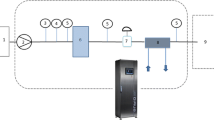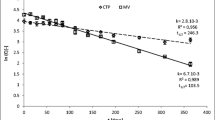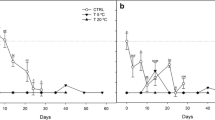Abstract
Thermal processing extends the shelf life of fruit and vegetables products by inactivating microorganisms and enzymes. The effect of a pasteurization (P) treatment, 90 ± 2 °C for 35 s, provided by continuous semi-industrial microwave (MW) under different conditions (high power/short time and low power/long time) or conventional pasteurization (CP) on orange-colored smoothies and their changes throughout 45 days of storage at 5 °C were investigated. Results indicated that vitamin C and antioxidant capacity (FRAP) in CP decreased dramatically in comparison with the unheated and MWP smoothies. On the contrary, all heating treatments increased the contents of total phenolic compounds and carotenoids. Based on the sensory quality and microbial counts, the shelf life of all those heated smoothies reached 45 days. No Listeria monocytogenes growth was found and all microbial counts were below the European legal limits (2007). MWP as compared to the CP method led to a greater reduction of mesophilic bacteria after 45 days at 5 °C (3.7 log cfu g−1 for CP and 1.6 log cfu g−1 for MWP). The highest power and the shortest time MWP treatments (3600 W for 93 s), resulted into better preservation of FRAP and vitamin C.





Similar content being viewed by others
References
Ahmed J, Ramaswamy HS (2007) Handbook of Food Preservation. Microwave pasteurization and sterilization of foods, Chap 28, 2nd edn. Taylor & Francis Group, The University of São Paulo, São Paulo, pp 708–710
AOAC (1984) Official methods of analysis Association of Official Agricultural Chemists, 14th edn. AOAC, Virginia, pp 414–420
Arjmandi A, Oton M, Artés F, Artés-Hernandez F, Gómez P, Aguayo E (2016) Continuous microwave pasteurization of a vegetable smoothie improves its physical quality and hinders detrimental enzyme activity. Food Sci Technol Int. doi:10.1177/1082013216654414
ASTM (1986) Physical requirements guidelines for sensory evaluation. American Society for Testing and Materials Publications, Publication 913, Philadelphia
Azizah AH, Wee KC, Azizah O, Azizah M (2009) Effect of boiling and stir frying on total phenolics, carotenoids and radical scavenging activity of pumpkin (Cucurbita moschato). Int Food Res J 16:45–51
Canumir JA, Celis JE, Bruijn DJ, Vidal LV (2002) Pasteurization of apple juice by using microwave. Lebensm Wiss Technol 35:389–392
Capanoglu E, Beekwilder J, Boyacioglu D, Vos RCH, Hall RD (2010) The Effect of industrial food processing on potentially health-beneficial tomato antioxidants. Int J Food Sci Technol 50:919–930
Chuah AM, Lee YC, Yamaguchi T, Takamura H, Yin LJ, Matoba T (2008) Effect of cooking on the antioxidant properties of colored peppers. Food Chem 111:20–28
Clare DA, Bang WS, Cartwright G, Drake MA, Corone P, Simunovic J (2005) Comparison of sensory, microbiological, and biochemical parameters of microwave versus indirect UHT fluid skim milk during storage. J Dairy Sci 88:4172–4182
Crozier A, Lean MEJ, McDonald MS, Black C (1997) Quantitative analysis of the flavonoid content of commercial tomatoes, onions, lettuce and celery. J Agric Food Chem 45:590–595
D’Evoli L, Lombardi-Boccia G, Lucarini M (2013) Influence of heat treatments on carotenoid content of cherry tomatoes. Foods 2:352–363
Dewanto V, Wu X, Adom KK, Liu RH (2002) Thermal processing enhances the nutritional value of tomatoes by increasing total antioxidant activity. J Agric Food Chem 50:3010–3014
Falagán N, Artés F, Aguayo E (2015) Natural additives to preserve quality and improve nutritional value of fresh-cut nectarin. Food Sci Technol Int. doi:10.1177/108201321562181
Favell DJ (1998) A comparison of the vitamin C content of fresh and frozen vegetables. Food Chem 62:59–64
Fratianni A, Cinquanta L, Panfili G (2010) Degradation of carotenoids in orange juice during microwave heating. J Food Sci Technol 43:867–871
Gentry TS, Roberts JS (2005) Design and evaluation of a continuous flow microwave pasteurization system for apple cider. J Food Sci 38:227–238
Igual M, García-Martínez E, Camacho MM, Martínez-Navarrete N (2010) Effect of thermal treatment and storage on the stability of organic acids and the functional value of grapefruit juice. Food Chem 118:291–299
Jacob K, García-Alonso FJ, Ros G, Periago MJ (2010) Stability of carotenoids, phenolic compounds, ascorbic acid and antioxidant capacity of tomatoes during thermal processing. Archivos Latinoamericanos de Nutrición versión impresa. ISSN: 0004-0622. ALAN v.60 n.2 Caracas
Keenan DF, Brunton NP, Gormley TR, Butler F, Tiwari BK, Patras A (2010) Effect of thermal and high hydrostatic pressure processing on antioxidant activity and colour of fruit smoothies. Innov Food Sci Emerg Technol 11:551–556
KlimczaK I, Malecka M, Szlachta M, Gliszcynska A (2007) Effect of storage on the content of polyphenols, vitamin C and the antioxidant activity of orange juices. J Food Compos Anal 20:313–322
Knoerzer K, Regier M, Hardy EH, Schuchmann HP, Schubert H (2009) Simultaneous microwave heating and three-dimensional MRI temperature mapping. Innov Food Sci Emerg Technol 10:537–544
Leoni C (2002) Improving the nutritional quality of processed fruits and vegetables: the case of tomatoes. In: Jongen W (ed) Fruit and vegetable processing: improving quality. Woodhead Publishing and CRC Press, Cambridge, pp 83–122
Macheix JJ, Fleuriet A, Billot J (1990) Fruit phenolics. CRC Press, Boca Raton
Martínez-Hernández GB, Francisco Artés-Hernández F, Perla A, Gómez PA, Artés F (2013) Quality changes after vacuum-based and conventional industrial cooking of kailan-hybrid broccoli throughout retail cold storage. Food Sci Technol Int 50:707–714
Math R, Nagender A, Nayani S, Satyanarayana A (2014) Continuous microwave processing and preservation of acidic and non acidic juice blends. IJAFST 2:81–90
Nagata M, Yamashita I (1992) Simple method for simultaneous determination of chlorophyll and carotenoids in tomato fruit. J Jpn Soc Food Sci 39:926–928
Navarro JM, Pérez-Pérez JG, Romero P, Botía P (2010) Analysis of the changes in quality in mandarin fruit, produced by deficit irrigation treatments. Food Chem 119:1591–1596
Park SH, Lamsal BP, Balasubramaniam VM (2014) Food processing: principles and applications, 2nd edn. Wiley, New York
Picouet PA, Landl A, Abadias M, Castellari M, Viñas I (2009) Minimal processing of a Granny Smith apple purée by microwave heating. Innov Food Sci Emerg Technol 10:545–550
Plaza L, Sánchez-Moreno C, Elez-Martínez P, de Ancos B, Martín-Belloso O, Cano MP (2006) Effect of refrigerated storage on vitamin C and antioxidant activity of orange juice processed by high-pressure or pulsed electric fields with regard to low pasteurization. Eur Food Res Technol 223:487–493
Podşedek A (2007) Natural antioxidants and antioxidant capacity of Brasicca vegetables: a review. Lebensm Wiss Technol 40:1–11
Podşedek A, Sosnowska D, Anders B (2003) Antioxidative capacity of tomato products. Eur Food Res Technol 217:296–300
Quartey EK, Amoatey HM, Achel DG, Klu GYP, Mba RA (2012) Induced mutations for improved lycopene, total antioxidant properties and other quality factors in wild tomato (Solanum pimpinellifolium L.). J Food Sci Technol 4:182–188
Regulation EC 1441/2007 (2007) Commission regulation on microbiological criteria for food stuffs. Off J Eur Union L322:12–29
Robinson JP, Kingman SW, Snape CE, Shang H, Barranco R, Saeid A (2009) Separation of polyaromatic hydrocarbons from contaminated soils using microwave heating. Sep Purif Technol 69:249–254
Rodríguez-Verásteguil LL, Ginés Benito Martínez-Hernández GB, Castillejo N, Gómez PA, Artés F, Artés-Hernández F (2015) Bioactive compounds and enzymatic activity of red vegetable smoothies during storage. Food Bioprocess Technol 9:137–146
Rusell LF (2004) Handbook of food analysis. Physical characterisation and nutrient analysis, vol 1. Marcel Dekker, New York, pp 487–571
Sharma SK, Le Maguer M (1996) Kinetics of lycopene degradation in tomato pulp solids under different processing and storage conditions. Food Res Int 29:309–315
Shi J, Dai Y, Kakuda Y, Mittal G, Xue SJ (2008) Effect of heating and exposure to light on the stability of lycopene in tomato puree. Food Control 19:514–520
Stahl W, Sies H (1992) Uptake of lycopene and its geometrical isomers is greater from heat-processed than from unprocessed tomato juice in humans. J Nutr 122:2161–2166
Tajchakavit S, Ramaswamy HS (1995) Continuous-flow microwave heating of orange juice: evidence of nonthermal effects. J Microw Power Electromagn Energy 30:141–148
Tarazona-Díaz MP, Aguayo E (2013) Influence of acidification, pasteurization, centrifugation and storage time and temperature on watermelon juice quality. J Sci Food Agric 93:3863–3869
Teixeira AA (2012) Simulating thermal food processes using deterministic models. In: Wen-Sun D (ed) Thermal food processing: new technologies and quality issues. CRC Press, Boca Raton, p 98
Vámos-Vigyázó L (1981) Polyphenoloxidase and peroxidase in fruits and vegetables. Crit Rev Food Sci Nutr 15:49–127
Van het Hof KH, de Boer BCJ, Tijburg LBM, Lucius BRHM, Zijp I, West CE, Hautvast JGAJ, Weststrate JA (2000) Carotenoid bioavailability in humans from tomatoes processed in different ways determined from the carotenoid response in the triglyceride-rich lipoprotein fraction of plasma after a single consumption and in plasma after four days of consumption. J Nutr 130:1189–1196
Zhang D, Hamauzu Y (2004) Phenolics, ascorbic acid, carotenoids and antioxidant activity of broccoli and their changes during conventional and microwave cooking. Food Chem 88:503–509
Acknowledgments
This work was financially supported by MINECO-FEDER (AGL2013-48830-C2-1-R). Thanks are due to Instituto de Biotecnología Vegetal (IBV-UPCT) for providing some of the equipment.
Author information
Authors and Affiliations
Corresponding author
Rights and permissions
About this article
Cite this article
Arjmandi, M., Otón, M., Artés, F. et al. Semi-industrial microwave treatments positively affect the quality of orange-colored smoothies. J Food Sci Technol 53, 3695–3703 (2016). https://doi.org/10.1007/s13197-016-2342-5
Revised:
Accepted:
Published:
Issue Date:
DOI: https://doi.org/10.1007/s13197-016-2342-5




